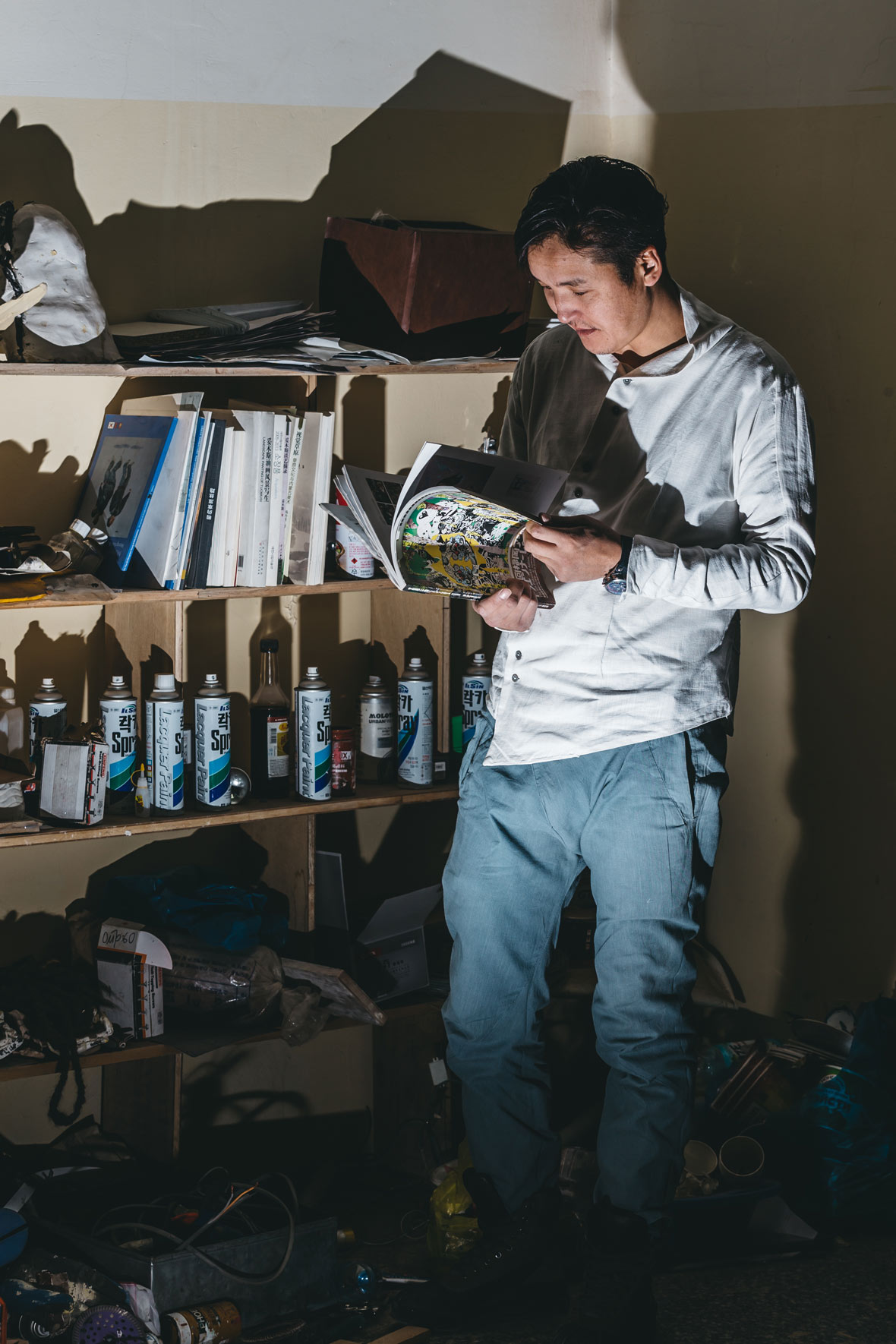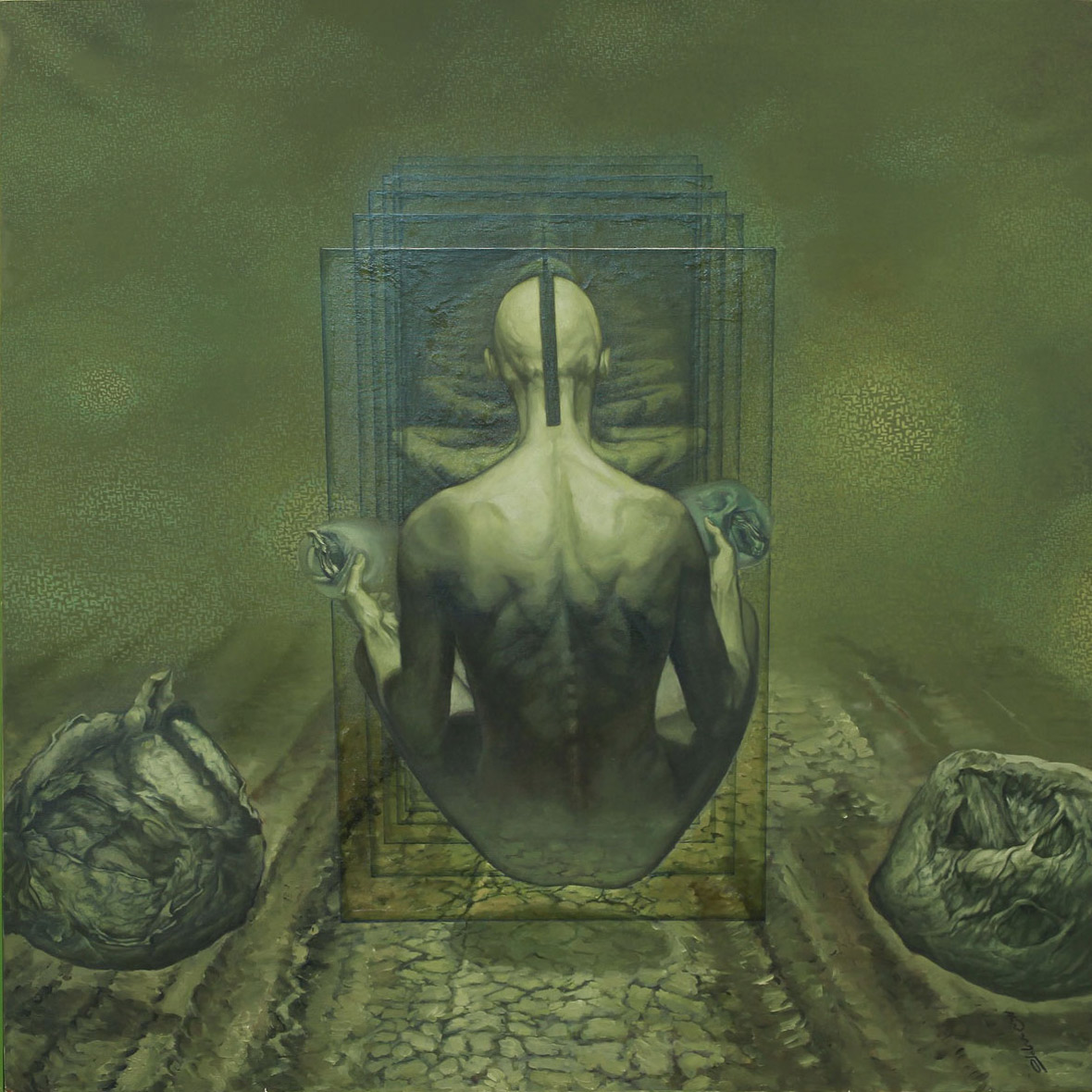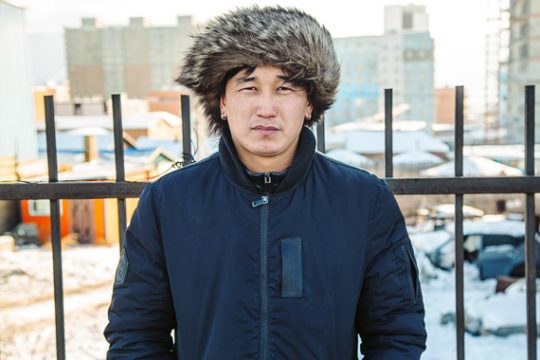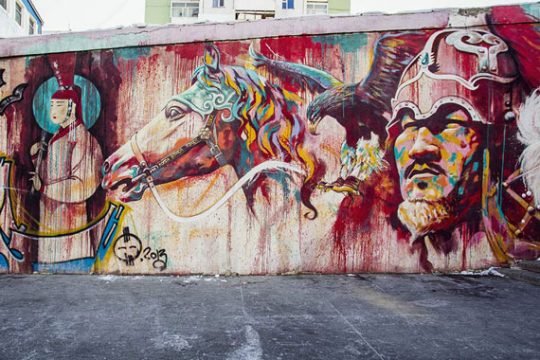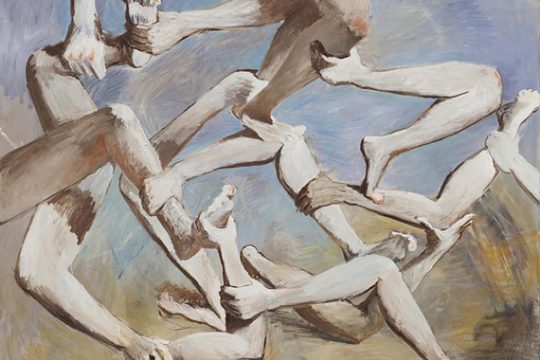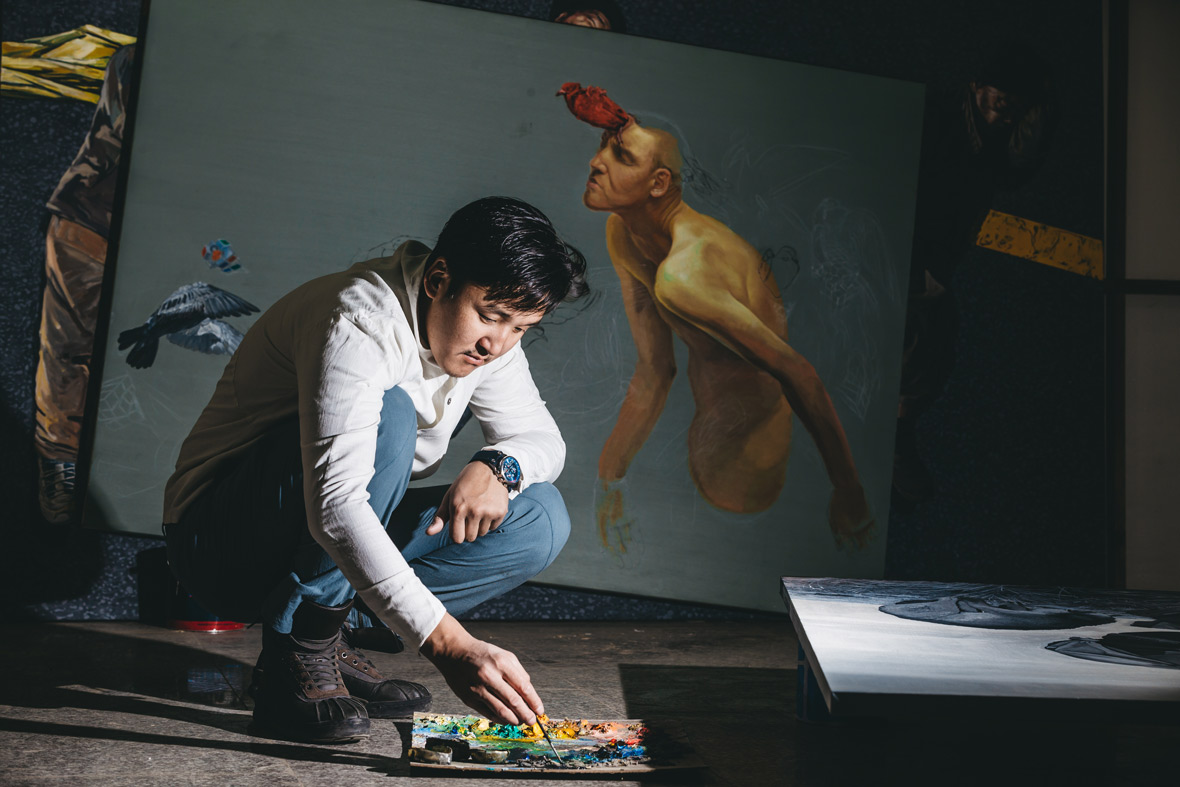
Orkhontuul Banzragch is a visual artist whose surrealist paintings have attracted increasing attention in the Mongolian art scene. Since the induction of his Face of painting into Mongolia’s State Treasury in 2014, Orkhontuul’s work has been heralded as the new wave of Mongolian art. His style is distinct and doesn’t fit the mold of traditional Mongolian art, which might include predictable imagery of horses, wolves, nomadic warriors, and the great wilderness. Instead, Orkhontuul prefers portraits, which, more often than not, are based on himself or people in his life. He wields his art as a vessel in which he can share his commentary on the struggles of modern-day Mongolians – touching on modern issues such as the national identity crisis, the population’s collective nostalgia for a supposedly glorious past, among other sociopolitical topics. As such, despite his nonconformist style, Orkhontuul is widely regarded as an artist who creates authentic Mongolian art.
Orkhontuul Banzragch是近年来蒙古艺术界中崭露头角的视觉艺术家。2014年,他的《Face of》一画被选入蒙古国库(Mongolia’s State Treasury),其作品也被标榜为蒙古族的艺术新浪潮。他的作品的特别之处,在于它偏离了蒙古族的传统艺术模式,譬如大多数蒙古艺术作品都会出现马、狼、游牧战士和大荒原等形象。相反,他的作品多为超现实主义的肖像画,这些肖像画往往是以他自己或他身边的人为原型创作的。通过自己的艺术,他展现出自己对现代蒙古人所经历的挣扎的看法,譬如是民族认同问题危机,或是蒙古人民对这个民族过去辉煌历史的集体缅怀。因此,尽管他的风格不拘于传统,他仍被蒙古人们视为是创作正宗蒙古艺术的艺术家。
A recent visit to his studio took us to the outskirts of Ulaanbaatar city and into the basement of a newly built apartment complex. The space, sparsely decorated and dimly lit, is split into two rooms. The second room belongs to Lkhagvadorj, a local artist who’s sharing the space. Orkhontuul tells us that the primary reason for choosing this location was because of affordability – the two artists have a rather unorthodox arrangement with the landlord where they’re allowed to pay rent with their paintings. The secondary reason is because of its remoteness; it’s even an hour-long commute for Orkhontuul himself to get there, but this was a deliberate decision, as he wants to discourage frequent visitors and focus on his work without distractions. Undeterred by Orkhontuul wishes of being left alone to his art, we sat down with him and had a long chat about the challenges of being an artist in Mongolia and breaking free from “generic Mongolian art.”
我们最近拜访了他的工作室,那是乌兰巴托市郊区一幢新建公寓大楼的地下室。工作室内没什么装饰,光线暗淡,被分成了两个房间,这是他与另一名当地艺术家Lkhagvadorj共享的工作室。Orkhontuul告诉我们,之所以选择这里作为工作室,最主要的原因是因为它价格便宜。其次是因为它位置偏远——Orkhontuul自己每天也要花一个小时才能到工作室——这是他深思熟虑后作出的决定:因为他不想工作室有太多的访客,这样才能专注于自己的创作。虽然Orkhontuul更享受一个人的时间,但我们还是和与Orkhontuul坐了下来长谈,跟他聊聊关于蒙古艺术家所面临的挑战,以及突破挑战“传统蒙古艺术风格”的困难。
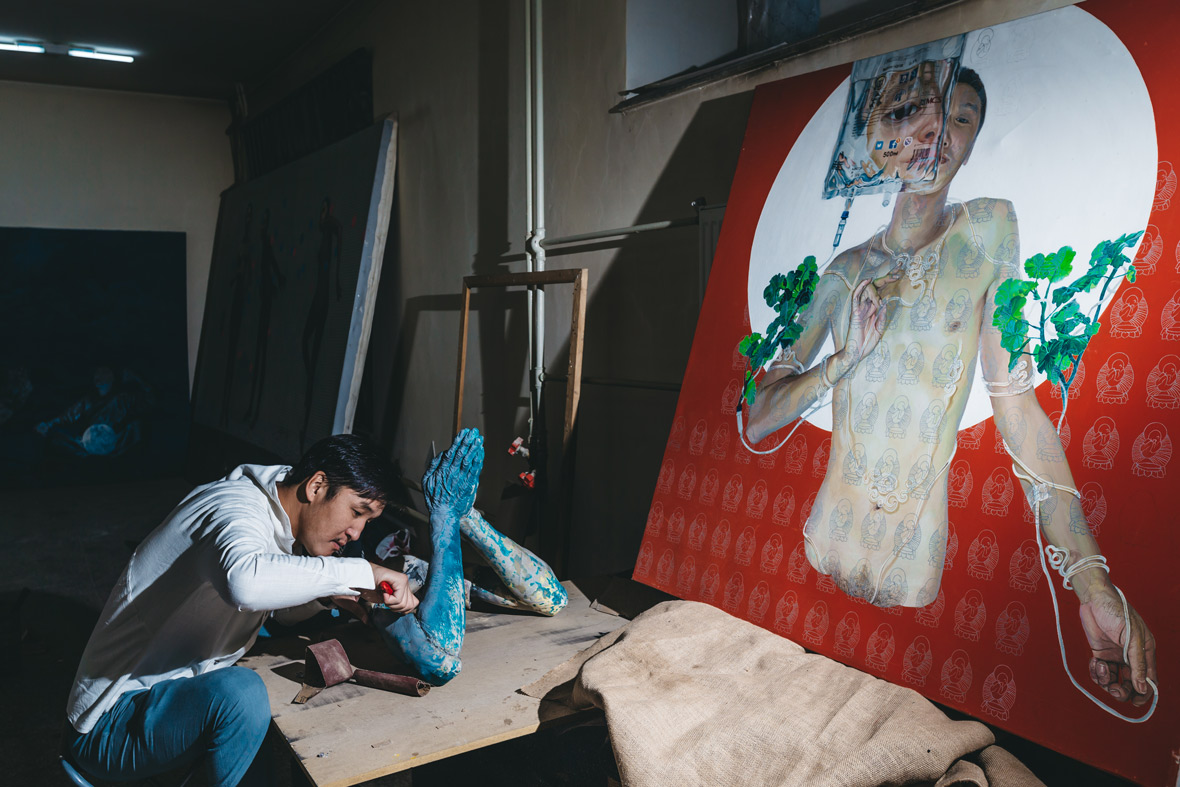
Neocha: Did you choose art or did art choose you?
Orkhontuul: It’s not that I wanted or chose to be an artist like you would choose a profession. I think some people can choose their profession, but for example, artists like painters, musicians, singers and composers are not privy to that because they can’t choose their talent. I believe talent is something predestined. Unlike other artists, I would say I’m lucky, in that none of my family members have expressed disapproval in me drawing or painting. My father is a composer, so I think him being an artist probably helped me continue down this path. Either way, my family probably had no way to stop a kid who started painting before he could even crawl.
Neocha: 你觉得是你选择了艺术这条路,还是艺术它选择了你?
Orkhontuul: 关于这一点,我觉得不是像平时人们选择职业那样的,不是说是我想要成为或者说选择了成为一名艺术家。有些人是可以选择自己的职业,但是像画家、音乐家、歌手和作曲家这些艺术家是不同的,才华不是一件可以选择的事情。我相信才华是命中注定的。我会说自己很幸运,因为不像其他艺术家,我的家人都没有反对我画画。我的父亲是一名作曲家,我觉得有一位艺术家父亲让我更加坚定地走艺术创作这条道路。但不管怎样,我的家人可能也没有办法阻止我,毕竟在我还没学会爬的时候,我就先会画画了。
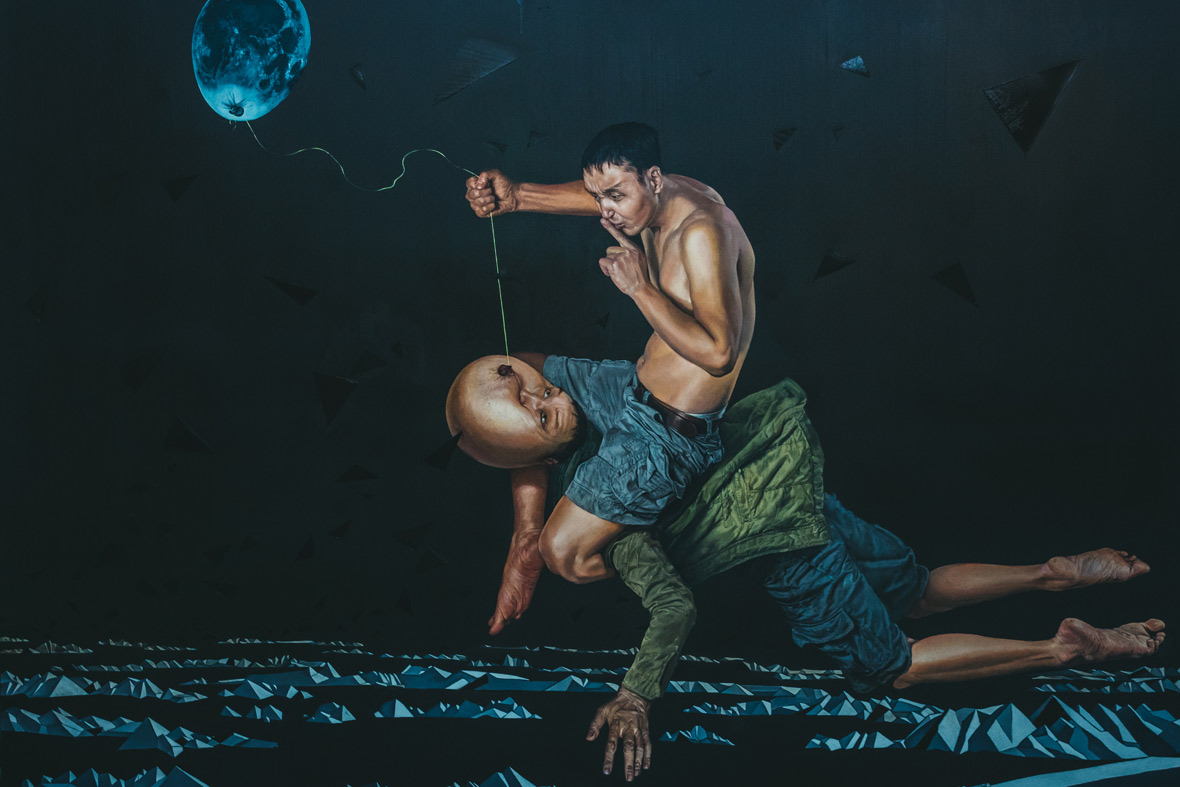
Neocha: Your paintings capture the hardships and struggles of modern Mongolians. Why are these issues so important to you?
Orkhontuul: I think everyone in Mongolia has their own feelings on the current state of things. But as an artist I just see and feel it as images so I express it in that way. There are people, like journalists, who can explain whats happening today with their writing, but someone like me just can’t explain it with words. My art is just what I have seen and experienced in our society, which at times, might be what I feel to be injustices. These things just come out as a painting for me. I’m not trying to advocate for any cause or use my art as like a banner or an ad for something. I am just painting what I see, but I don’t strictly paint images focused on social commentary.
Neocha: 很多人说你的画作展示出了现代蒙古人的艰辛和挣扎。为什么这些主题对你来说如此重要?
Orkhontuul: 我想每个人对当下的事物都会有自己的感受。但是,作为一名艺术家,我的所见所感对我来说都是一个个画面,所以我还是以画画的方式表达出来。有些人,譬如记者,他们可以用文字来解释当下发生的事情,而我可能无法用语言来做到这一点。我的艺术正是我在社会上的见闻和经历,无论它是否不公正。只是我会通过画画来表达出这些东西。我并没有想通过自己的艺术作品来倡议任何事情或是用它作为一面旗帜或广告去宣传任何东西。我只是在画我所见到的事物。我并非只专注创作有关社会问题的画像。
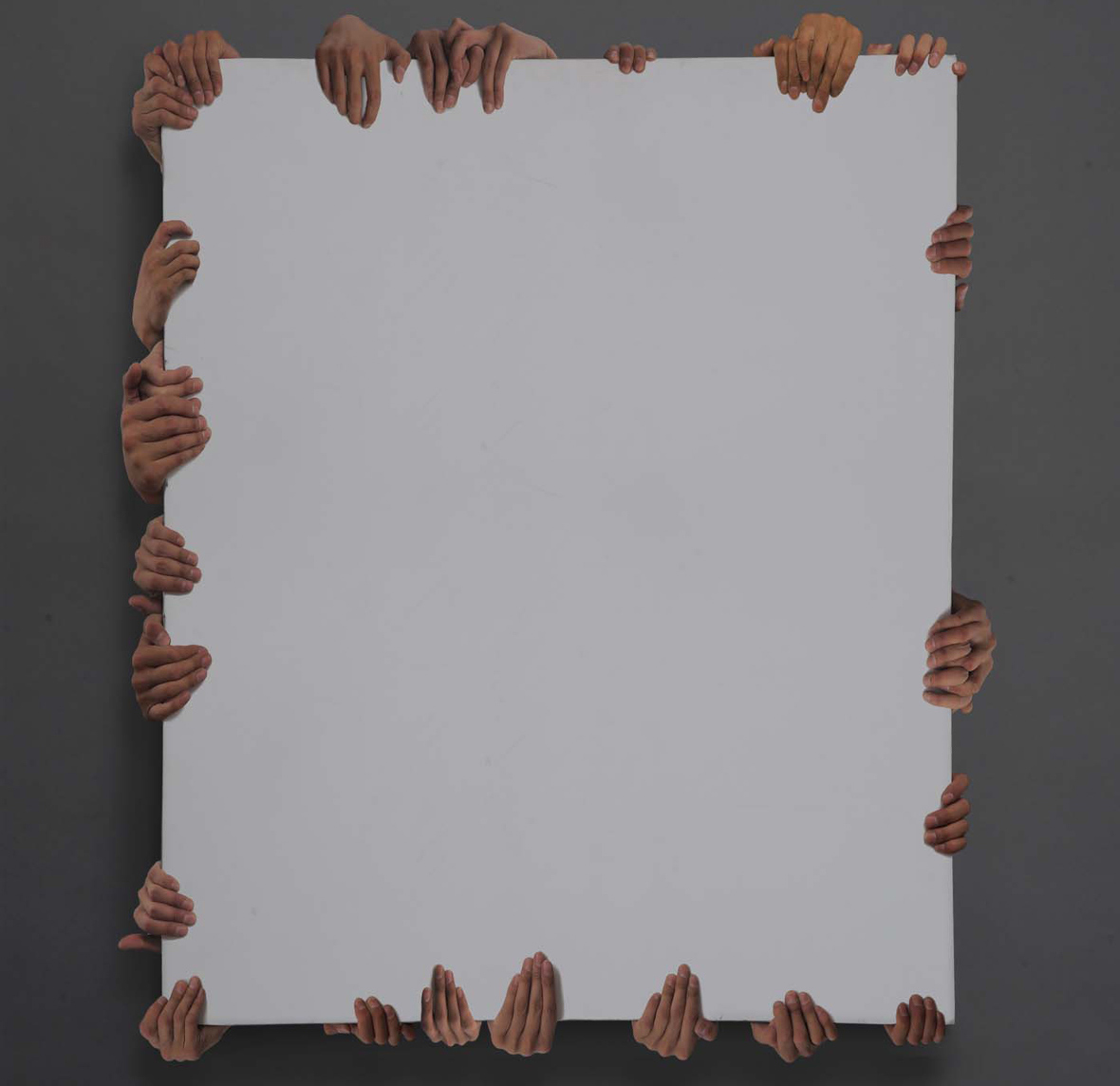
Neocha: Are you actively searching for inspiration or do you just have spontaneous “lightbulb” moments?
Orkhontuul: It varies. Sometimes inspiration just comes to me when I’m walking down the street. It comes from things I hear or see. I think artists should be very acute and peckish. Since my student days, I’ve constantly searched for things that can inspire me, and because of that tendency, I’ve learned a lot and am even more eager to search out the next thing that can inspire me. If something sparks my interest then I’ll try to make something out if it.
Neocha: 你画画的灵感从何而来?你平时会不断去搜寻灵感,还是就灵光一闪,下笔如神?
Orkhontuul: 不一定。有时,我在街上走着走着,灵感就出现了。可能是来自我听到或看到的事物。我觉得艺术家应该保持敏锐,并始终充满渴求。从学生时期开始,我就会不断去寻找能激发灵感的事物。这样也更能提升我的敏锐度和求知欲。如果有什么东西引起了我的兴趣,我就会努力尝试从中创作些什么。
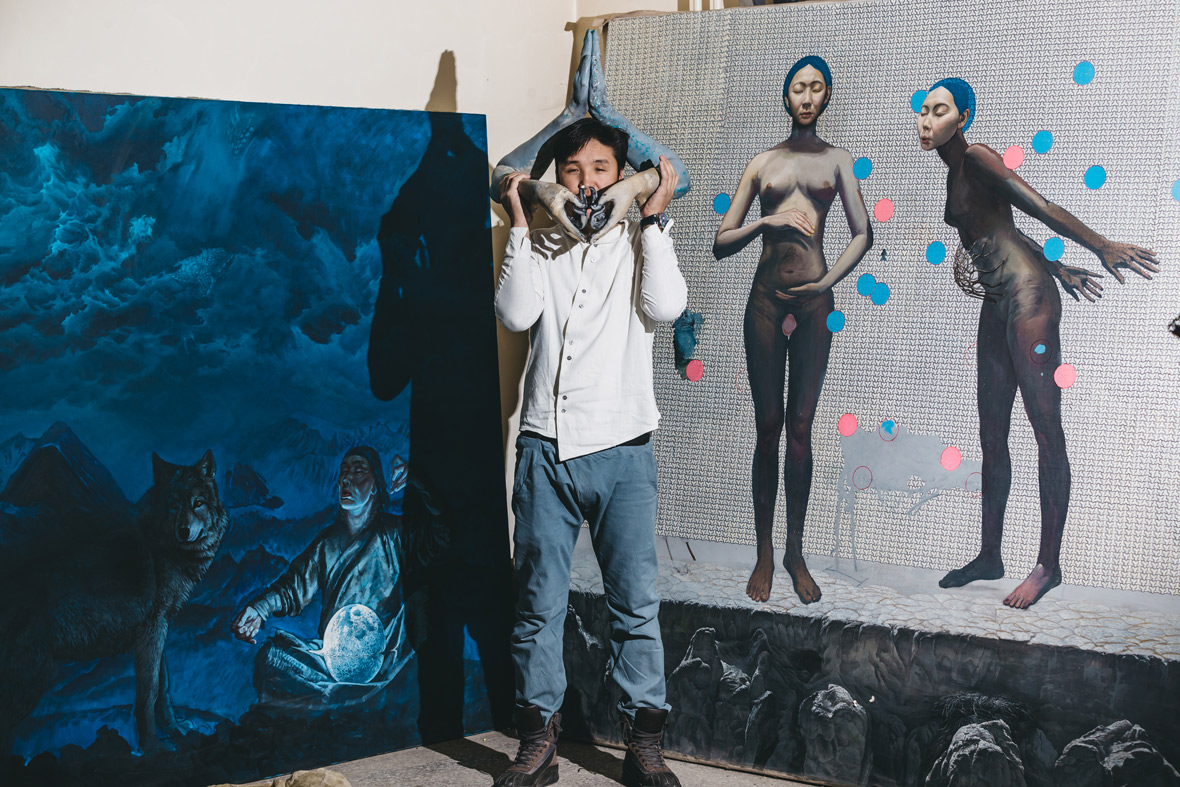
Neocha: Most Mongolian art is littered with generic subjects like horses, wolves, beautiful woman, and so on. What are your thoughts on the prevalence of these subject matters in Mongolian art?
Orkhontuul: I think some of these paintings have a different purpose from art. Some artists draw these things not because they want to, but they have to make a living. These types of paintings should not be considered art in my opinion. I, for one, would never paint a wolf just for the purpose of making money. I might use an image of a wolf if I’m trying to express something specific in my paintings, but I’ll never think that I should incorporate a certain element because it’s the norm.
Neocha: 大部分蒙古族艺术作品中都充满了像马、狼、美丽女性等形象。对于蒙古艺术中这些题材的流行泛滥你有什么看法?
Orkhontuul: 我觉得这些画不是以艺术为目的创作的。有些画家画这些画并非出于自己的意愿,而是为了谋生而画。在我看来,这样的画不应该被视为艺术。拿我来说,我永远也不会为了赚钱而去画一匹狼。只有当我觉得狼可以用来表达某种具体意义时,我才会去画,但我从来不会因为某种元素或形象很流行,就把它加入到自己的作品中。
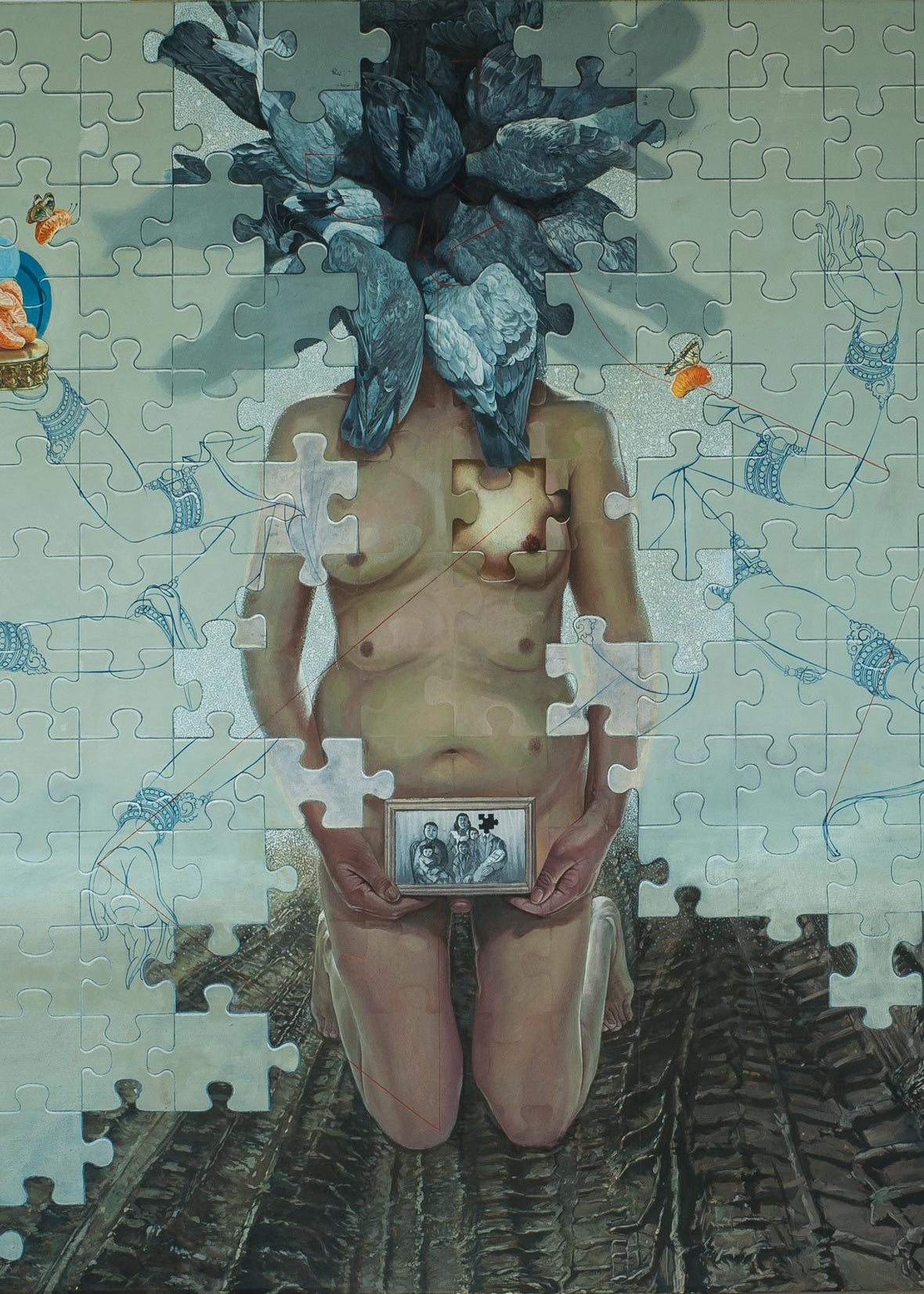
Neocha: Can you tell us about this piece named “Mother”? It’s quite different from some of your other work, and there’s quite a lot to digest in the frame.
Orkhontuul: This painting is actually based on a real person that I met. I don’t have many interests or hobbies in life except for painting and traveling. I love to travel. There were times just on a whim I would just hitch a ride to the countryside. One time, when I was on a train, an old lady barged into my cabin holding a bottle of vodka, and with a growly voice, she said “Let’s share a drink.” She was one of those ladies that goes to China to buy cheap goods and sell it here at the local market. And maybe because of her profession and stress, she looked more like a man than a woman. All the joy she had seemed to have faded away. She told me she does to support her family. And that is why in the painting she has four breasts – every breast represents one of her children. Her missing face represents the losing her feminine identity, and the pigeons are her stressful thoughts of feeding her hungry children. The missing puzzle pieces are things that left her life – husband and love. She has a penis because she had to essentially “become a man” to live, but the silhouette of the many arms that surround her is meant to represent that she is still a goddess. That’s what I wanted to portray but other people might look at it and see something different.
Neocha: 你能跟我们介绍一下这幅名为《母亲》(Mother)的作品吗?它和你的其它作品有很大的不同,整个画面有相当多值得注意的元素。
Orkhontuul: 这幅画其实是以我认识的一个人为原型创作的。除了画画和旅游,我在生活中没有太多的兴趣爱好。我喜欢旅行。有几次,只是一时兴起,我就去了搭顺风车到农村。有一次,我坐在火车上,一位老太太闯进我的车厢,拿着一瓶伏特加酒,对我吼着说:“让我们一起来喝一杯吧。”她和很多妇女一样,都是去中国买些便宜货,然后拿回当地市场转卖。也许是因为她的职业和压力,她看起来更像一个男人。她曾经的快乐似乎已经消磨殆尽。她告诉我,她要支撑起整个家。这就是为什么在画里,她有四个乳房,因为每一个乳房都代表了她的一个孩子。她所缺少的面部,代表了她所失去的女性身份,而鸽子则是她忙于喂养饥饿的孩子们所承受的压力。缺少的拼图是指她的生活中所缺少的丈夫和爱。她之所以有男性的生殖器,是因为她被迫“作为男性”来生活,但“千手观音”的轮廓又表示她仍然是一名女神。这就是我想表达的意义。当然,其他人看到这幅画时可能会有不同的看法。
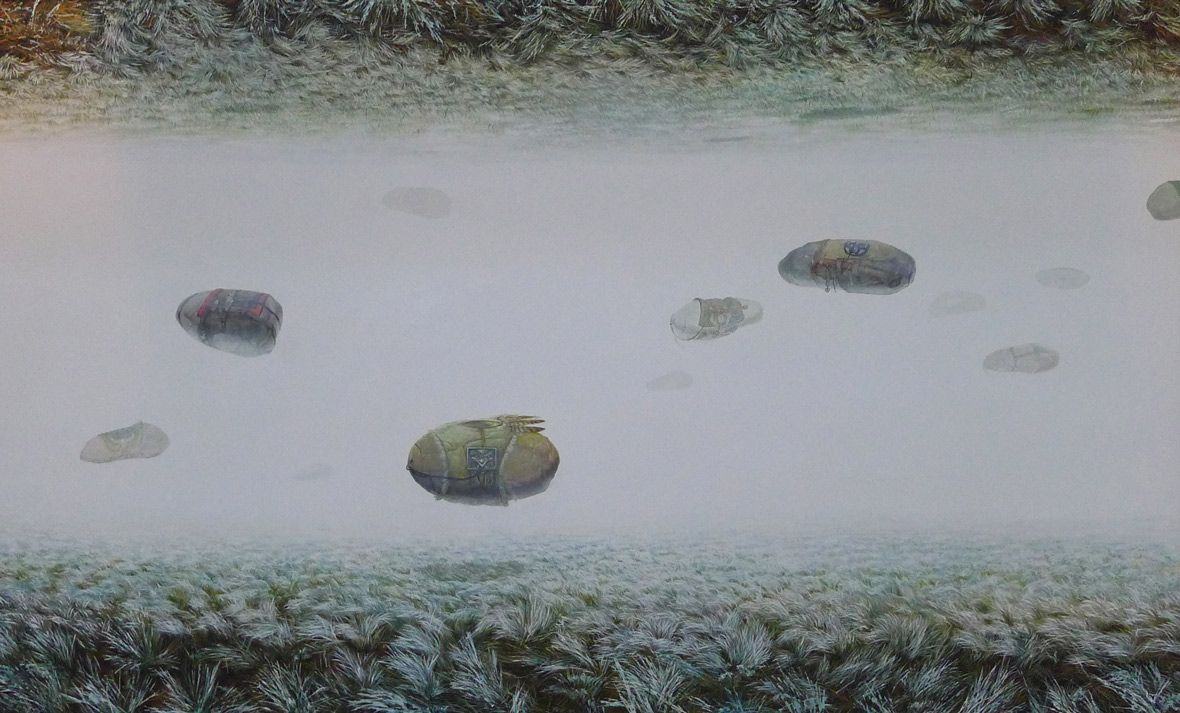
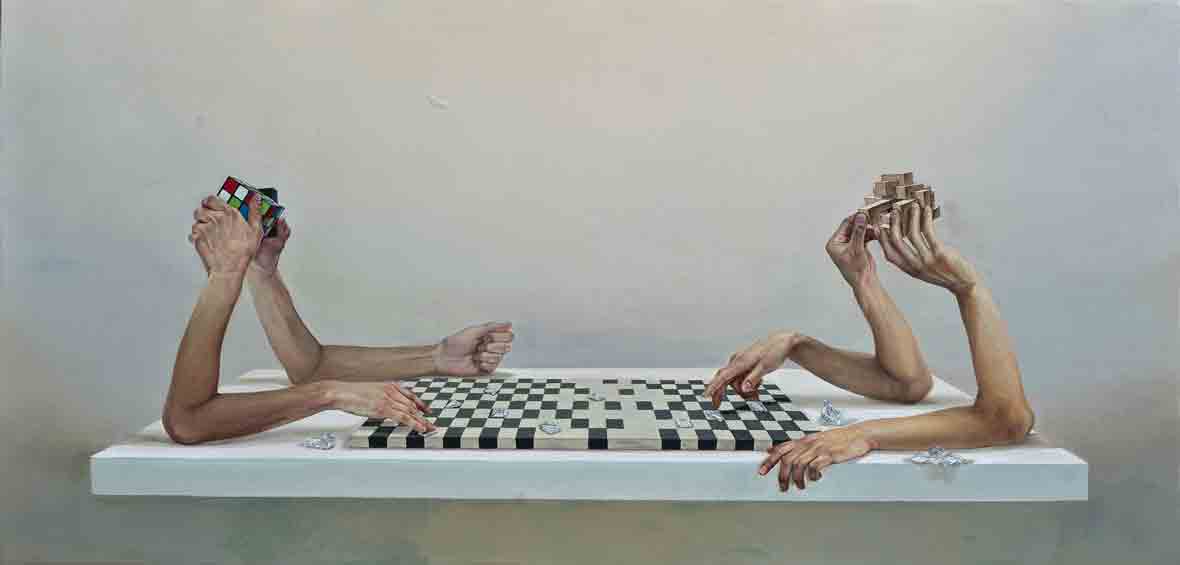
Neocha: It sounds there’s a lot of contemplation involved in how you want to present your messages. How long does it usually take you to complete a painting from start to finish?
Orkhontuul: I can’t truly say. I usually start on a painting, and I’ll stop and comeback to it later. I usually don’t think about it when I start on a certain painting. Sometimes, a piece might take me more than a year to finish, but the actual time I spend putting my brush to canvas probably isn’t longer than a month. I am one of those people who will get frustrated or hate what I am painting if I force myself to finish a painting when the inspiration isn’t there. For some artists, there are paintings that might’ve taken them more than ten years to finish. If the painter paints without stopping, he or she would have produced hundreds of paintings like that. It takes them that long because something will go wrong – they might have gone into a rut, they might have to do research, maybe they’re just not feeling it, or maybe the painting turns into something they did not want or expect. Sometimes, they might just want to scrap it altogether.
Neocha: 听起来,对于画面所传递的内容,你需要经过很多思考。那么通常来说,你需要花多长时间完成一幅画?
Orkhontuul: 不好说。我常常开始画一幅画,画到中间就停下来,过后又回头继续画。每次开始创作一幅画时,我都不会去想要花多长时间。有时候,一幅画我可能要画一年多才能完成,但实际上真正下笔画的时间可能不超过一个月。我是那种如果没有灵感还要强迫自己作画时,就会对在画的东西感到很失望、甚至产生厌恶的人。有一些艺术家可能会用十几年的时间才能完成一幅画作。但其实,如果画家不间断地画,这么长的时间足以创作出数百幅画作。之所以需要这么长的时间,是因为创作的过程不是一帆风顺的,画家可能突然感到枯燥乏味,或是需要去进行更多研究,也可能觉得不想画了,或者是画着画着,发现画跟他们预期和期待的不一样。或者有时,他们可能只是想要毁掉了重新再画。
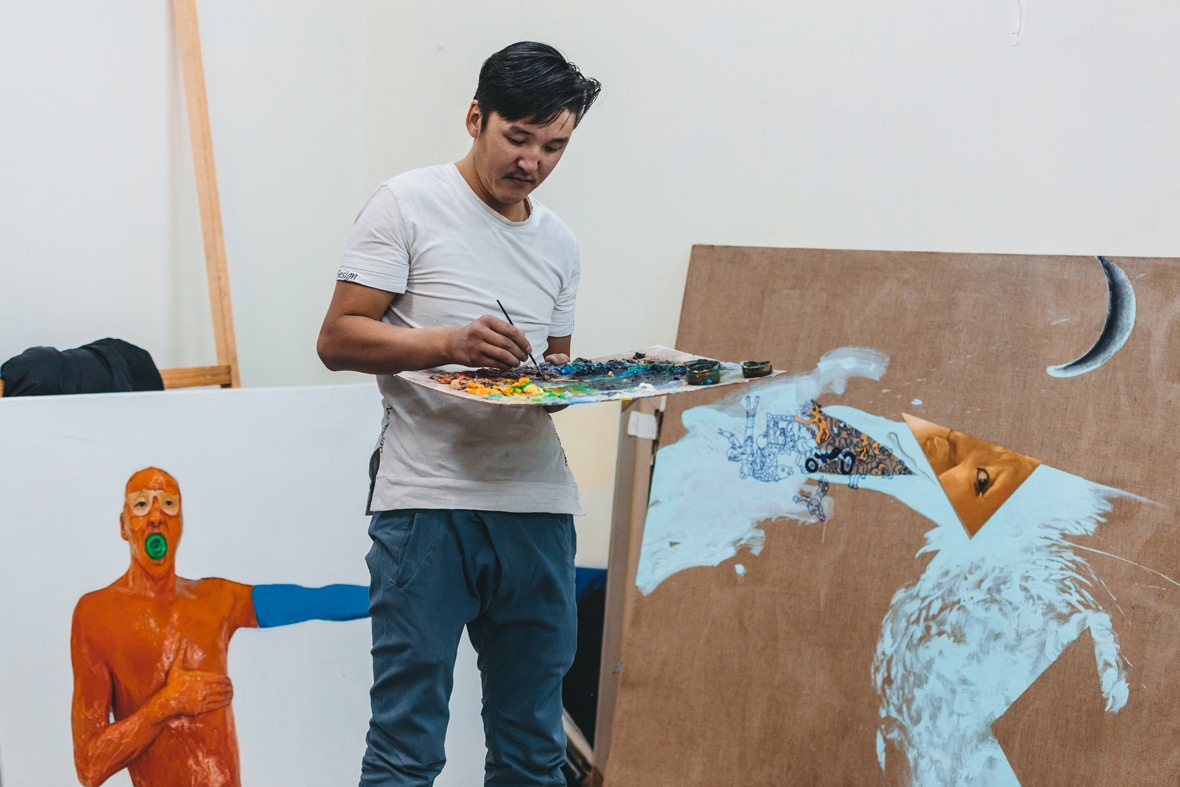
Neocha: You seem quite empathetic towards the hardships of other people, but what are some of the challenges that you yourself face as an artist in Mongolia?
Orkhontuul: You do have to pick up odd jobs and work on commissions to earn money and make a living. It’s impossible to just work on your own art and make a living off of that. But, the way I see it is that whenever I’m working these odd jobs, I’m buying time for myself to pursue what I want to paint.
Neocha: 你在作品中充满了对他人艰辛生活的同情,那你自己作为一名蒙古艺术家,又面临怎样的挑战?
Orkhontuul: 你必须做零工,接受客人委托的画画工作来挣钱谋生。想单纯靠自己的画来谋生几乎是不可能的。但我的想法是,我做这些零活,就是为了让自己有更多的时间去追求我真正想要的创作理想。

